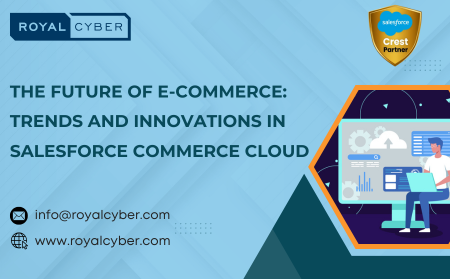
The area of e-commerce is experiencing constant changes, as a result of the development of new technologies and changes in customers’ needs and demands. Another company leading this change is Salesforce Commerce Cloud which is an e-commerce platform that enables such businesses to deliver excellent digital experiences.
Let’s delve into some of the key trends and innovations shaping the future of e-commerce and how Salesforce Commerce Cloud is driving them:
Machine learning and its subset artificial intelligence
Personalized Shopping Experiences:
Customers’ data is put through algorithms within the AI to give personalized products, content and promotions.
Predictive Analytics:
AI helps Salesforce Commerce Cloud in demand planning, inventory management and sales promotion chance evaluation.
Chatbots and Virtual Assistants:
Chat bots powered by Artificial Intelligence act as the customers’ representatives and offer their help, respond to questions and help the buyers to complete their transaction.
Headless Commerce
Flexibility and Agility: Headless commerce allows the simplification of the commercial layer, integrating the presentation layer and the commerce core separately, thus providing businesses with flexibility to deliver omnichannel commerce.
Seamless Integration: ECM of Salesforce Commerce Cloud solutions easily interconnects with all front-end technologies and channels to offer a single efficient commerce strategy.
Social Commerce
Leveraging Social Platforms: Social commerce refers to the shopping experience that occurs within social media Sites and allows users to find, share and even buy products in their social networks.
Influencer Partnerships: Salesforce Commerce Cloud also supports working with influencers for the post of the brands and products on the social networks.
Mobile Commerce
Mobile-First Experiences: Based on the theme of mobility, Salesforce Commerce Cloud offers clients customizable and optimized solutions for any mobile device.
Mobile-Specific Features:
Some of the things include but are not limited to mobile friendly product galleries, one click checkout and mobile friendly payments systems.
Specific applications discussed Augmented Reality (AR) and Virtual Reality (VR).
Augmented Reality (AR) and Virtual Reality (VR) are the two main type of interactive display that combines both real and virtual images.
Immersive Shopping Experiences:
The reality created by AR and VR allows customers to see the product in place and use it, contributing to the customers’ experience and minimizing returns.
Virtual Try-On: Salesforce Commerce Cloud implements new capabilities of AR so that customers can wear clothes, put on accessories, and apply makeup.
Sustainable E-commerce
Eco-Friendly Practices: Sustainability strategies, including avoidance of wastage of packaging, usage of environmentally friendly and socially responsible raw materials, and promotion of fair trade, are being implemented popularly by a growing number of companies.
Transparent Supply Chains:
Salesforce Commerce Cloud provides companies with tools to identify and trace the origin of goods and disclose information regarding the company’s sustainable policies to the consumers.
Voice Commerce
Voice-Activated Shopping:
AI enabled digital speakers such as Amazon Alexa and Google Assistant are steadily changing the configured shopping experience that prefers voice-enabled product search and purchase.
Voice-Optimized Experiences:
It also enables voice search of product catalogs by enhancing product data for better outcomes for Salesforce Commerce Cloud.
These trends, along with the powerful platform provided by Salesforce Commerce Cloud, can help businesses capture new opportunities and succeed in providing their customers with great experiences in the constantly developing environment of e-commerce. For Salesforce cloud solutions you can contact us







